Abstract
Correlations between the presence of certain trace metals in dental enamel or in drinking water and the incidence of human dental caries have been demonstrated; therefore, the effects of several trace metals on growth of the cariogenic organism Streptococcus mutans OMZ176 were determined. For continuous growth in a chemically defined medium (treated with Chelex-100 to lower trace metal contamination and supplemented with high-purity trace metal salts) used in a chemostat constructed of Teflon, S. mutans required input of carbon dioxide and supplementation with magnesium (126 microM) and manganese (18 to 54 microM). Addition of iron (3.6 microM) increased the level of steady-state growth by a factor of 2.8 (stimulation index [SI]); zinc at 0.4 microM nearly doubled equilibrium growth (SI = 0.9). Higher concentrations of iron and zinc (5.4 and 0.8 microM, respectively) were less stimulatory (SI values of 1.95 and 0.3, respectively). Small (but statistically significant) increases in steady-state growth were effected by cobalt (SI = 0.3 at 5.1 to 20.4 microM) and tin (SI = 0.4 at 5.1 to 10.2 microM). These data suggest nutritional requirements for these metals. Copper at a concentration of 0.16 microM was inhibitory. These results show significant effects of these metals on growth of S. mutans and may confirm epidemiological evidence suggesting a role for certain trace metals in the incidence of dental caries.
Full text
PDF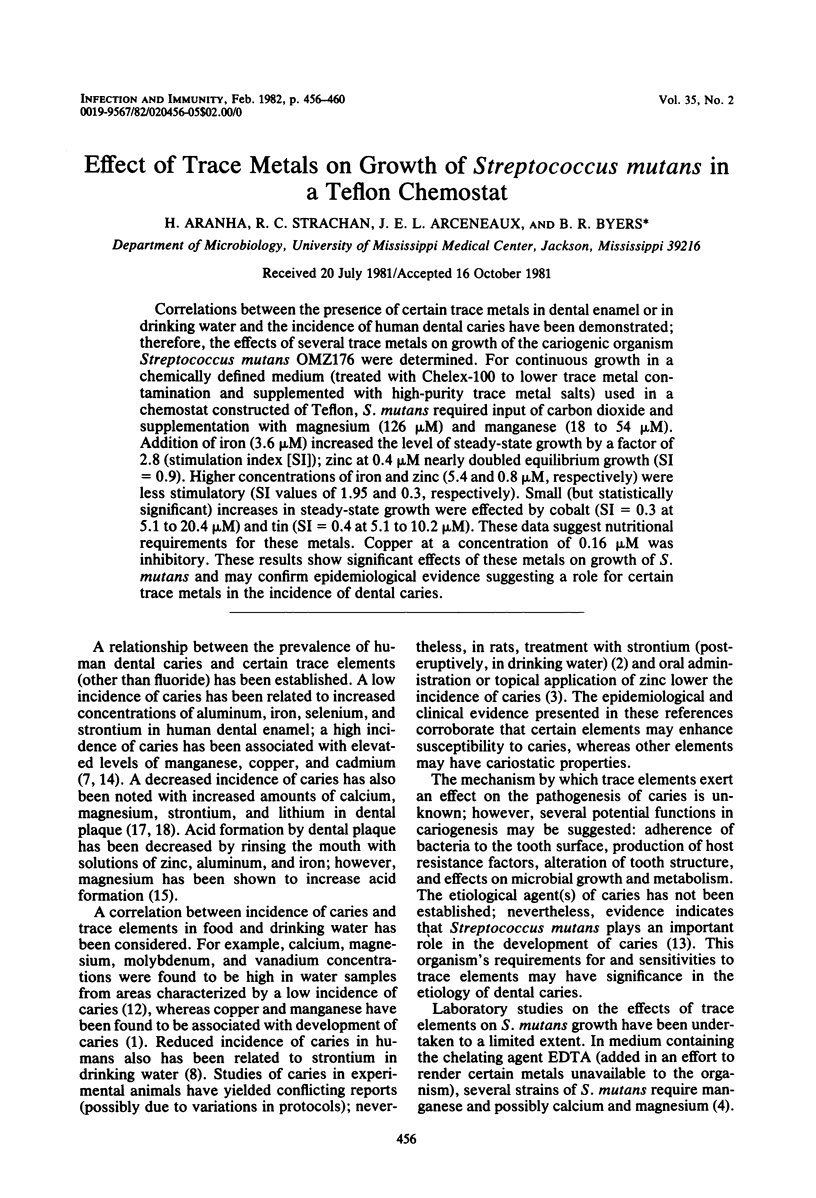
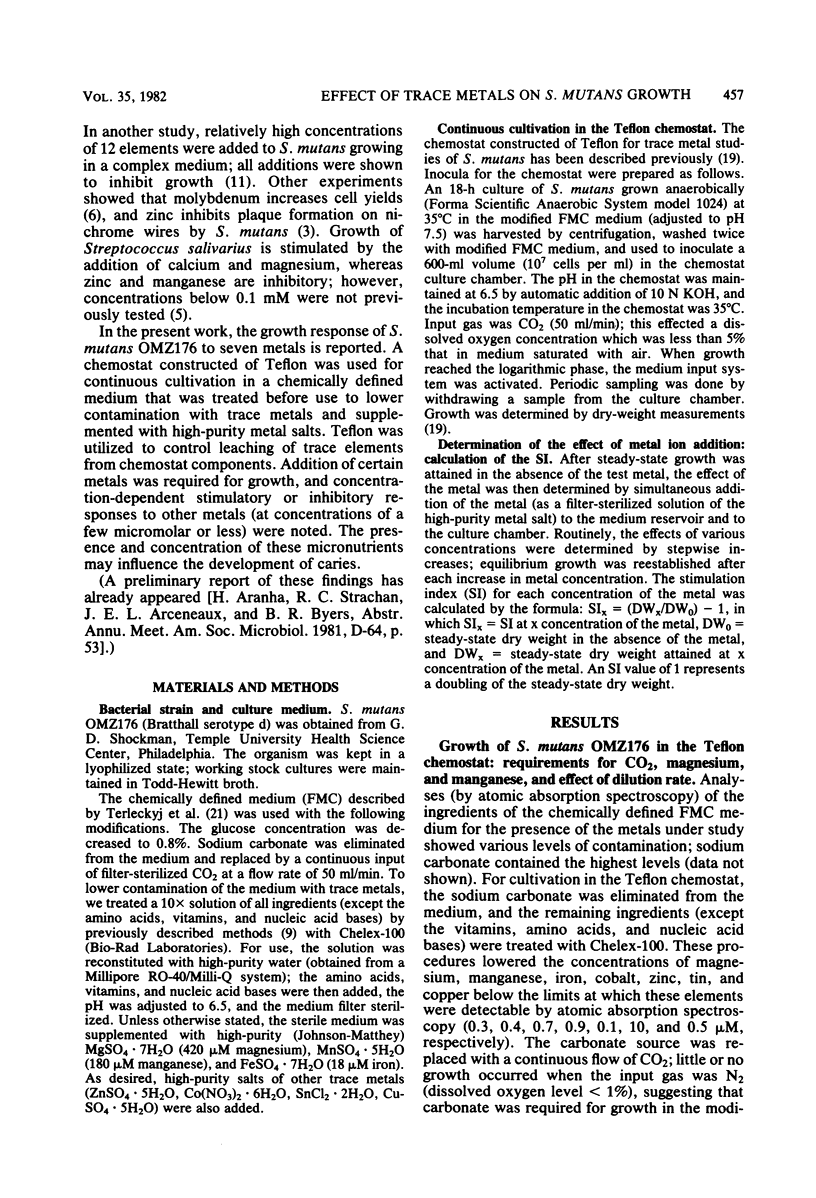
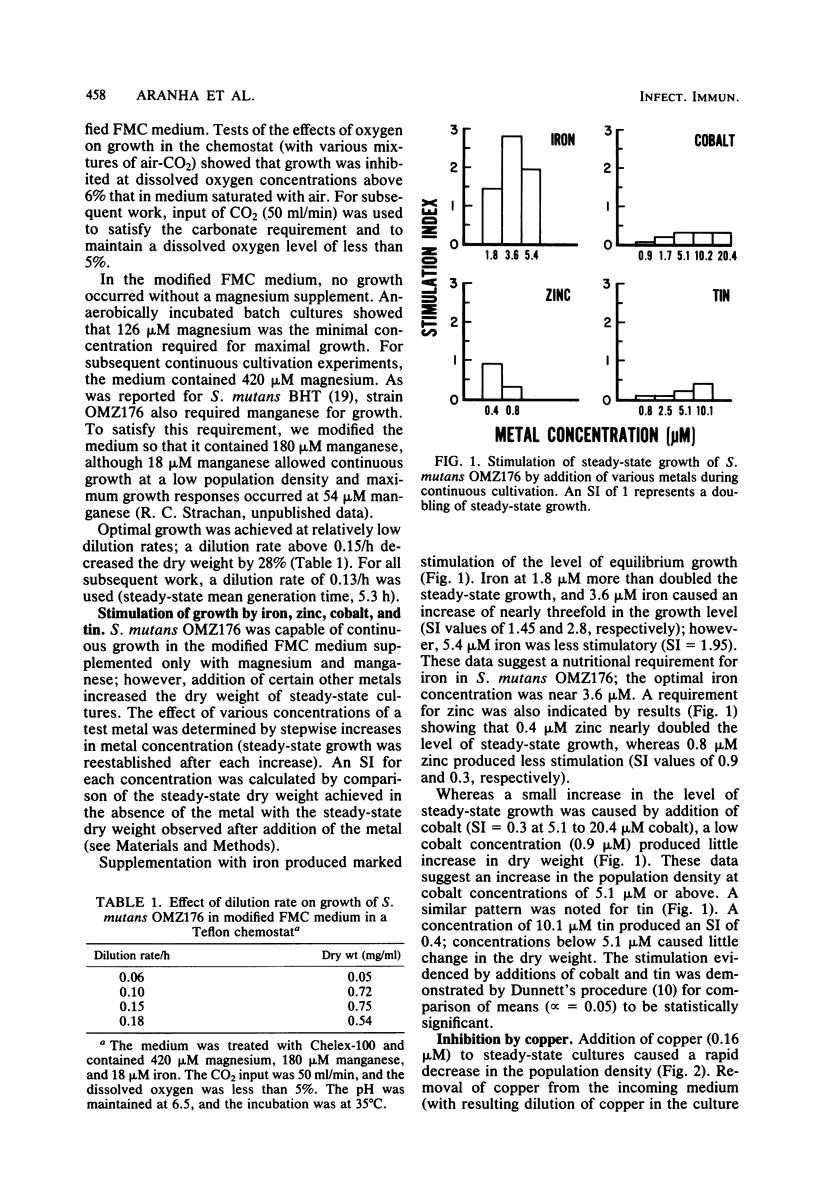
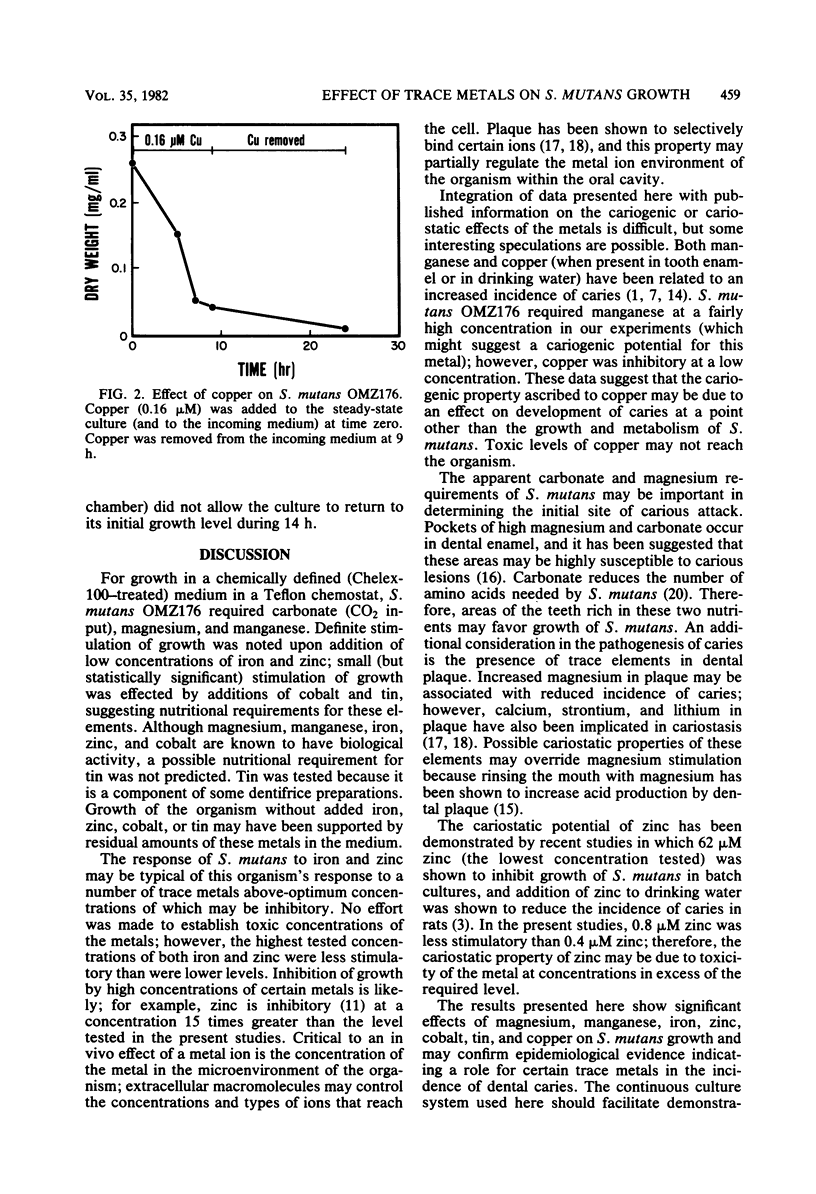
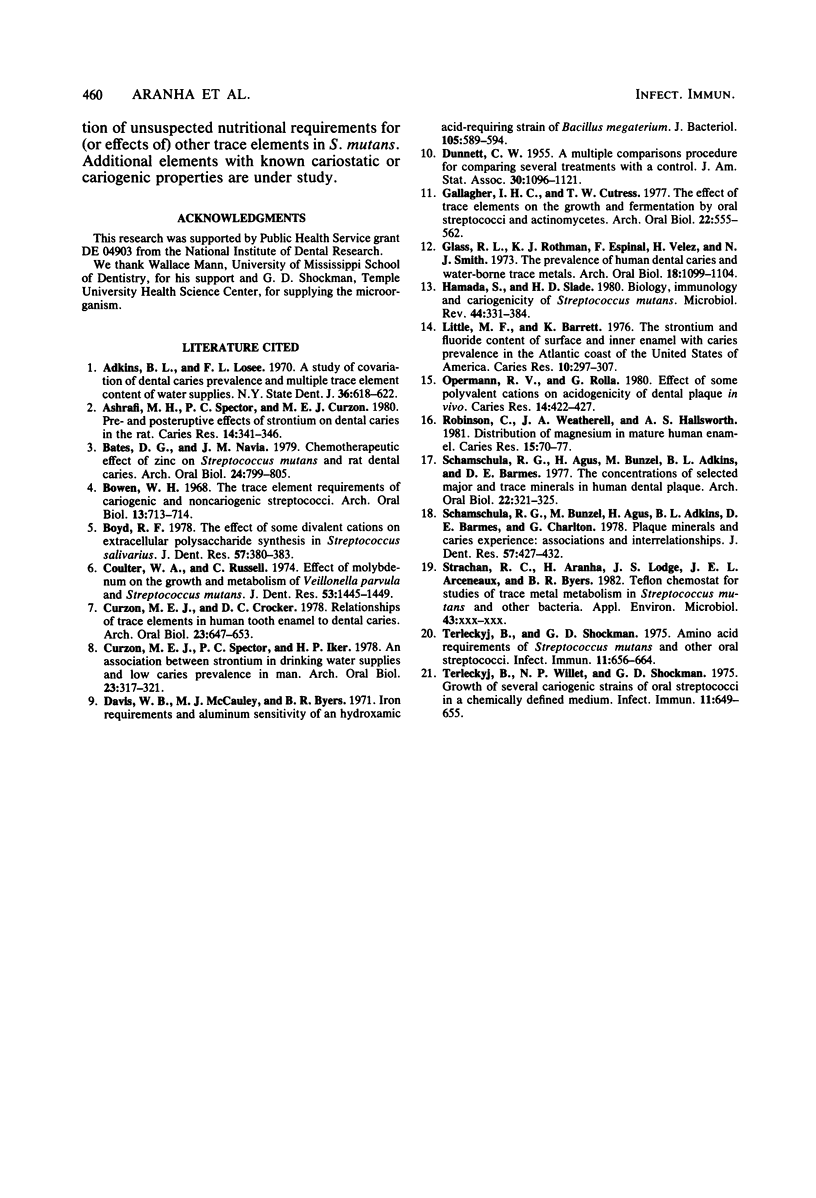
Selected References
These references are in PubMed. This may not be the complete list of references from this article.
- Adkins B. L., Losee F. L. A study of the covariation of dental caries prevalence and multiple trace element content of water supplies. N Y State Dent J. 1970 Dec;36(10):618–622. [PubMed] [Google Scholar]
- Ashrafi M. H., Spector P. C., Curzon M. E. Pre- and posteruptive effects of low doses of strotium on dental caries in the rat. Caries Res. 1980;14(5):341–346. doi: 10.1159/000260473. [DOI] [PubMed] [Google Scholar]
- Bates D. G., Navia J. M. Chemotherapeutic effect of zinc on streptococcus mutans and rat dental caries. Arch Oral Biol. 1979;24(10-11):799–805. doi: 10.1016/0003-9969(79)90041-4. [DOI] [PubMed] [Google Scholar]
- Bowen W. H. The trace element requirements of cariogenic and non-cariogenic streptococci. Arch Oral Biol. 1968 Jun;13(6):713–714. doi: 10.1016/0003-9969(68)90151-9. [DOI] [PubMed] [Google Scholar]
- Boyd R. F. The effect of some divalent cations on extracellular polysaccharide synthesis in Streptococcus salivarius. J Dent Res. 1978 Feb;57(2):380–383. doi: 10.1177/00220345780570024001. [DOI] [PubMed] [Google Scholar]
- Coulter W. A., Russell C. Effect of molybdenum on the growth and metabolism of Veillonella parvula and Streptococcus mutans. J Dent Res. 1974 Nov-Dec;53(6):1445–1449. doi: 10.1177/00220345740530062601. [DOI] [PubMed] [Google Scholar]
- Curzon M. E., Crocker D. C. Relationships of trace elements in human tooth enamel to dental caries. Arch Oral Biol. 1978;23(8):647–653. doi: 10.1016/0003-9969(78)90189-9. [DOI] [PubMed] [Google Scholar]
- Curzon M. E., Spector P. C., Iker H. P. An association between strontium in drinking water supplies and low caries prevalence in man. Arch Oral Biol. 1978;23(4):317–321. doi: 10.1016/0003-9969(78)90025-0. [DOI] [PubMed] [Google Scholar]
- Davis W. B., McCauley M. J., Byers B. R. Iron requirements and aluminum sensitivity of an hydroxamic acid-requiring strain of Bacillus megaterium. J Bacteriol. 1971 Feb;105(2):589–594. doi: 10.1128/jb.105.2.589-594.1971. [DOI] [PMC free article] [PubMed] [Google Scholar]
- Gallagher I. H., Cutress T. W. The effect of trace elements on the growth and fermantation by oral streptococci and actinomyces. Arch Oral Biol. 1977;22(10-11):555–562. doi: 10.1016/0003-9969(77)90066-8. [DOI] [PubMed] [Google Scholar]
- Glass R. L., Rothman K. J., Espinal F., Vélez H., Smith N. J. The prevalence of human dental caries and water-borne trace metals. Arch Oral Biol. 1973 Sep;18(9):1099–1104. doi: 10.1016/0003-9969(73)90083-6. [DOI] [PubMed] [Google Scholar]
- Hamada S., Slade H. D. Biology, immunology, and cariogenicity of Streptococcus mutans. Microbiol Rev. 1980 Jun;44(2):331–384. doi: 10.1128/mr.44.2.331-384.1980. [DOI] [PMC free article] [PubMed] [Google Scholar]
- Little M. F., Barrett K. Strontium and fluoride content of surface and inner enamel versus caries prevalence in the Atlantic coast of the United States of America. Caries Res. 1976;10(4):297–307. doi: 10.1159/000260210. [DOI] [PubMed] [Google Scholar]
- Oppermann R. V., Rölla G. Effect of some polyvalent cations on the acidogenicity of dental plaque in vivo. Caries Res. 1980;14(6):422–427. doi: 10.1159/000260485. [DOI] [PubMed] [Google Scholar]
- Robinson C., Weatherell J. A., Hallsworth A. S. Distribution of magnesium in mature human enamel. Caries Res. 1981;15(1):70–77. doi: 10.1159/000260502. [DOI] [PubMed] [Google Scholar]
- Schamschula R. G., Agus H., Bunzel M., Adkins B. L., Barmes D. E. The concentration of selected major and trace minerals in human dental plaque. Arch Oral Biol. 1977;22(5):321–325. doi: 10.1016/0003-9969(77)90030-9. [DOI] [PubMed] [Google Scholar]
- Schamschula R. G., Bunzel M., Agus H. M., Adkins B. L., Barmes D. E., Charlton G. Plaque minerals and caries experience: associations and interrelationships. J Dent Res. 1978 Mar;57(3):427–432. doi: 10.1177/00220345780570030101. [DOI] [PubMed] [Google Scholar]
- Terleckyj B., Shockman G. D. Amino acid requirements of Streptococcus mutans and other oral streptococci. Infect Immun. 1975 Apr;11(4):656–664. doi: 10.1128/iai.11.4.656-664.1975. [DOI] [PMC free article] [PubMed] [Google Scholar]
- Terleckyj B., Willett N. P., Shockman G. D. Growth of several cariogenic strains of oral streptococci in a chemically defined medium. Infect Immun. 1975 Apr;11(4):649–655. doi: 10.1128/iai.11.4.649-655.1975. [DOI] [PMC free article] [PubMed] [Google Scholar]


